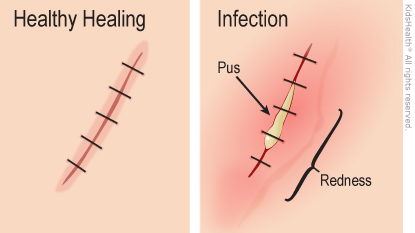The health care provider checked your child's facial cut and decided that stitches were needed to bring the two sides of the skin together. Some kinds of stitches need to be removed, but others dissolve on their own. Most cuts will leave a small scar. A healing cut can get infected, so the health care provider cleaned it carefully. You can help to prevent infection by taking good care of the cut as it heals.




The cut:

Why do health care providers stitch cuts? Some small cuts can heal on their own. But for cuts that are large, wide, or bleeding a lot, health care providers need to use stitches to bring the edges of the cut closer together (called closing the cut).
Why does a cut get a scar? When the deeper layer of skin is injured, the body uses a protein (collagen) to help fill in the cut area. The filled-in area becomes a scar. A scar will form even if a cut is fixed with stitches. Over time some scars fade or get smaller.